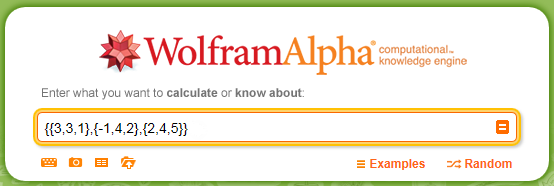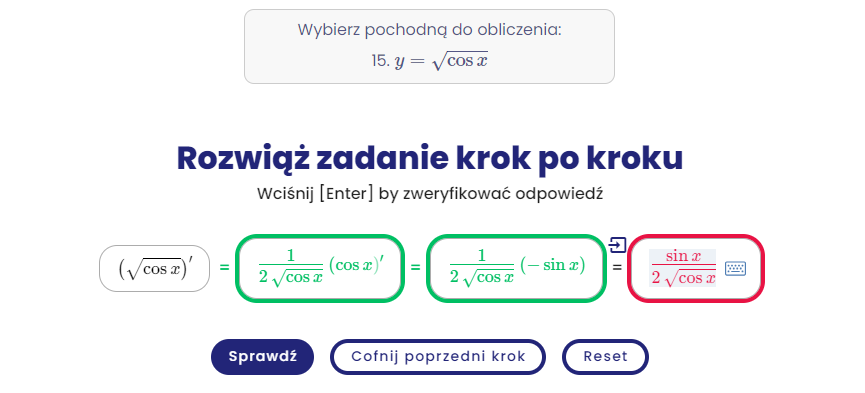Currently Empty: zł0.00

Eigen vectors and eigen values – what are they?
The eigen values and eigen vectors of matrices appear (or not) in studies as an extension of the topic of matrices. I did not include them in my Course, so those interested in the topic may find this post really useful.
What do you already need to know?
- matrices
- Polynomial equations from the mean (usually only of the second and third degree)
Step-by-step calculation of eigenvalues and vectors
- At the start given you have a square matrix (exclusively), say A. Only.
- You calculate the matrix {{A}_{\lambda }}=A-\lambda I where \lambda is some number that is an unknown, and I is a unitary matrix (that is, a square matrix that has ones on the diagonal and zeroes alone outside of them).
- You count the determinant of the matrix {{A}_{\lambda }}.
- This determinant is the so-called characteristic equation of the matrix. You equate it to zero and count its elements. These primes are precisely the eigenvalues of the matrix. You label them {{\lambda }_{1}},{{\lambda }_{2}},{{\lambda }_{3}} , …
- You insert the primes sequentially into the equation: {{A}_{\lambda }}X=0, where X is an unknown vector (i.e., a one-column matrix). You solve the equation. The solution will be a certain set of vectors X, each of which can be called an eigenvector.
Example 1 (with 2 degree square matrix)
Calculate the vectors and eigenvalues of the matrix A=\left[ \begin{matrix} 3 & 2 \\ 4 & 1 \end{matrix} \right].
I solve the task step by step according to the scheme above.
1.
A=\left[ \begin{matrix}3 & 2 \\4 & 1 \end{matrix} \right]2.
{{A}_{\lambda }}= \left[ \begin{matrix}3 & 2 \\4 & 1 \end{matrix} \right]-\lambda \cdot\left[ \begin{matrix}1 & 0 \\0 & 1 \end{matrix} \right] = \left[ \begin{matrix}3 & 2 \\4 & 1 \end{matrix} \right]-\left[ \begin{matrix}\lambda & 0 \\0 & \lambda \end{matrix} \right] = \left[ \begin{matrix}3-\lambda & 2 \\4 & 1-\lambda \end{matrix} \right]
3.
\left| \begin{matrix}3-\lambda & 2 \\4 & 1-\lambda \end{matrix} \right|=\left( 3-\lambda \right)\left( 1-\lambda \right)-2\cdot 4=3-3\lambda -\lambda +{{\lambda }^{2}}-8={{\lambda }^{2}}-4\lambda -5
4.
{{\lambda }^{2}}-4\lambda -5=0
\Delta ={{\left( -4 \right)}^{2}}-4\cdot 1\cdot \left( -5 \right)=16+20=36
{{\lambda }_{1}}=\frac{-\left( -4 \right)-\sqrt{36}}{2\cdot 1}=\frac{4-6}{2}=\frac{-2}{2}=-1
{{\lambda }_{2}}=\frac{-\left( -4 \right)+\sqrt{36}}{2\cdot 1}=\frac{4+6}{2}=\frac{10}{2}=5
The eigenvalues of the matrix are: -1 i 5 .
5.
Eigenvectors for {{\lambda }_{1}}=-1
For {{\lambda }_{1}}=-1:
{{A}_{{{\lambda }_{1}}}}=\left[ \begin{matrix}3-\left( -1 \right) & 2 \\4 & 1-\left( -1 \right) \end{matrix} \right]=\left[ \begin{matrix}4 & 2 \\4 & 2 \end{matrix} \right]
\left[ \begin{matrix}4 & 2 \\4 & 2 \end{matrix} \right]X=0
\left[ \begin{matrix}4 & 2 \\4 & 2 \end{matrix} \right]\left[ \begin{matrix}x \\y \end{matrix} \right]=\left[ \begin{matrix}0 \\0 \end{matrix} \right]
Hence (multiplying the matrix on the left and assimilating to the corresponding element of the matrix on the right):
\left\{ \begin{matrix}&4x+2y=0\\&4x+2y=0\\\end{matrix} \right.
That is, the relationship must be satisfied:
4x+2y=0
This equation satisfies infinitely many pairs of x and y , so it has infinitely many solutions.
That is, the eigenvectors for the eigenvalue {{\lambda }_{1}}=-1 are infinitely many.
For example, setting myself x=1 I will get 4\cdot 1+2y=0, or y=-2.
An example eigenvector therefore is:
\left[ \begin{matrix}1 \\-2 \end{matrix} \right]In general, meanwhile, the eigenvectors will have coordinates:
\left[ \begin{matrix}x \\-2x \end{matrix} \right]Because from the relationship 4x+2y=0 , it can be calculated that y=-2x.
Eigenvectors for {{\lambda }_{2}}=5
For {{\lambda }_{2}}=5:
{{A}_{{{\lambda }_{2}}}}=\left[ \begin{matrix}3-5 & 2 \\4 & 1-5\end{matrix} \right]=\left[ \begin{matrix}-2 & 2 \\4 & -4 \end{matrix} \right]
\left[ \begin{matrix}-2 & 2 \\4 & -4 \end{matrix} \right]X=0
\left[ \begin{matrix}-2 & 2 \\4 & -4 \end{matrix} \right]\left[ \begin{matrix}x \\y \end{matrix} \right]=\left[ \begin{matrix}0 \\0 \end{matrix} \right]
Now (again multiplying the matrices on the left and assimilating to the corresponding matrix element on the right):
\left\{ \begin{matrix}&-2x+2y=0\\&4x-4y=0\\\end{matrix} \right.
The system is – as always here – indefinite (it has infinitely many solutions), but I have a relationship:
This equation satisfies infinitely many pairs in which x=y, so it has infinitely many solutions.
That is, the eigenvectors for the eigenvalue {{\lambda }_{2}}=5 are infinitely many and generally have an equation:
\left[ \begin{matrix}x \\x \end{matrix} \right]For example, setting myself x=1 I will get an eigenvector:
\left[ \begin{matrix}1 \\1 \end{matrix} \right]Example 2 (with 3 degree square matrix)
Calculate the vectors and eigenvalues of the matrix A=\left[ \begin{matrix}2 & 1 & 0 \\-6 & 1 & -6 \\-3 & 1 & -1 \end{matrix} \right].
I solve the task step by step according to the same scheme.
1.
A=\left[ \begin{matrix}2 & 1 & 0 \\-6 & 1 & -6 \\-3 & 1 & -1 \end{matrix} \right]
2.
{{A}_{\lambda }}= \left[ \begin{matrix}2 & 1 & 0 \\-6 & 1 & -6 \\-3 & 1 & -1 \end{matrix} \right]-\lambda \cdot\left[ \begin{matrix}1 & 0 & 0 \\0 & 1 & 0 \\0 & 0 & 1 \end{matrix} \right] = \left[ \begin{matrix}2 & 1 & 0 \\-6 & 1 & -6 \\-3 & 1 & -1 \end{matrix} \right]-\left[ \begin{matrix}\lambda & 0 & 0 \\0 & \lambda & 0 \\0 & 0 & \lambda \end{matrix} \right] = \left[ \begin{matrix}2-\lambda& 1 & 0 \\-6 & 1-\lambda & -6 \\-3 & 1 & -1-\lambda \end{matrix} \right]
3.
I count with the Sarrus rule and have:
\left| A \right| = -{{\lambda }^{3}}+2{{\lambda }^{2}}-11\lambda +22
4.
-{{\lambda }^{3}}+2{{\lambda }^{2}}-11\lambda +22=0
Now mike with word grouping (as in high school):
{{\lambda }^{2}}\left( -\lambda +2 \right)+11\left( -\lambda +2 \right)=0
\left( {{\lambda }^{2}}+11 \right)\left( -\lambda +2 \right)=0
That is:
{{\lambda }^{2}}+11=0 lub -\lambda +2=0
{{\lambda }^{2}}+11 = 0 does not have solutions in real numbers (but if your professor requires counting eigenvalues in complex numbers as well, then go ahead, you will normally have two primes here – complex numbers).
-\lambda +2 = 0 \lambda = 2
The eigenvalue (in real numbers) of a matrix is: 2.
5.
Eigenvectors for {{\lambda }}=2
For \lambda=2:
\left[ \begin{matrix}2-2& 1 & 0 \\-6 & 1-2 & -6 \\-3 & 1 & -1-2\end{matrix} \right]=\left[ \begin{matrix}0& 1 & 0 \\-6 & -1 & -6 \\-3 & 1 & -3\end{matrix} \right]
\left[ \begin{matrix}0& 1 & 0 \\-6 & -1 & -6 \\-3 & 1 & -3\end{matrix} \right]X=0
\left[ \begin{matrix}0& 1 & 0 \\-6 & -1 & -6 \\-3 & 1 & -3\end{matrix} \right]\left[ \begin{matrix}x \\y \\z \end{matrix} \right]=\left[ \begin{matrix}0 \\0 \\0 \end{matrix} \right]
Hence(multiplying the matrix on the left and assimilating to the corresponding element of the matrix on the right):
\left\{ \begin{matrix}y=0\\-6x-y-6z=0\\-3x+y-3z=0\\ \end{matrix} \right.
Remember that it is always an indeterminate system, which has infinitely many solutions. To solve it, you can apply the Kronecker – Capelli theorem, but the one here is extremely simple. Taking into account that I have on the day y=0 I have from the other two equations:
And from these equations I have the relation z=-x.
That is, the eigenvectors for the eigenvalue \lambda=2 are infinitely many and can be described by the relation:
\left[ \begin{matrix}x \\0 \\-x \end{matrix} \right]An example eigenvector, on the other hand, could be:
\left[ \begin{matrix}1 \\0 \\-1 \end{matrix} \right]How to count vectors and eigenvalues in WolframAlpha?
If you just need a ready-made solution, or want to check the result for yourself, you can use Wolfram’s online calculator . Go to the website:
Then type into the search engine the matrix to which you want to count the values and eigenvectors as follows:
{{elements of 1st line separated by commas},{elements of 2nd line separated by commas},…}.
For example:
Then just confirm by clicking on ENTER.
Characteristic polynomial – you can read from the Characteristic polynomial field
Eigenvalues – you can read from the Eigenvalues field
Eigenvectors – you can read from the Eigenvectors field
Video
In another post I also recorded a video in which I show the calculation of eigenvalues and eigenvectors with 3 examples, feel free to join me:
Eigenvalues and Eigenvectors – 3 examples Video
Thank you
I hope that after reading this post and doing some examples, you will not have any problems with counting values and eigenvectors in your studies.
If you have any doubts, or examples you don’t understand – let me know in the comments under the post.




